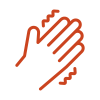What is Urinary Incontinence?
Urinary incontinence (UI), or bladder leakage, is the involuntary loss of urine. Urinary incontinence commonly occurs during perimenopause and postmenopause. The bladder and the urethra (the tube that carries the urine from your bladder and releases it outside the body) both contain estrogen receptors that work to keep your urinary system (or urinary tract) healthy.
As estrogen levels begin their decline in perimenopause, the receptors don’t receive the usual amount of estrogen. This causes the tissues making up the urethra and the bladder to change and become thinner, less muscular and have lower levels of blood flow. Urinary incontinence may also be associated with recurrent urinary tract infections (UTIs), a separate but associated symptom of perimenopause.
Urinary incontinence can happen at other life stages, often due to lack of exercise resulting in muscle weakness. In fact, one quarter to one third of men and women in the US experience symptoms of UI, most of them not in the menopausal transition. [1] [2] [3] [4]
Women may be reluctant to speak up and act on UI issues due to embarrassment and/or negative feelings about aging. However, these conditions can usually be treated at home, or with the help of a trusted medical practitioner.
There are several types of urinary incontinence:
Self-care & Natural Remedies for Urinary Menopause Incontinence
You can take significant steps to treat incontinence on your own with some straightforward lifestyle changes. Before you start any self-care or natural remedies, keep a diary for at least one or two weeks. Record when you have the urge to urinate and when you leak. This is your baseline and it will help you track your progress. [1] [7]

Self-Care & Natural Remedies
- ▢ Use your journal to identify and monitor triggers (like not urinating before you leave the house that can result in urge incontinence; running or jumping that can result in stress incontinence)
▢ Strengthen your pelvic floor muscles through pelvic floor muscle training, also known as Kegel exercises. Make sure your Kegel exercises are done correctly as they can otherwise cause some harm. Talk to your medical care provider or find a physiotherapy that specializes in pelvic floor exercises to get a pelvic floor muscle assessment and instructions on the correct form to practice Kegels at home. [8]
▢ Practice bladder training by scheduling bathroom visits. Use the information from your journal to figure out how often you typically urinate. Schedule bathroom visits for your usual interval + fifteen minutes. So if you normally go every hour, you would schedule a bathroom break every hour and 15 minutes.
▢ Practice bladder training by delaying urination. Whenever you feel the urge to urinate, hold it for 5 minutes before going. As you get stronger and have better control of holding urine without leaking, start to extend the delay time. If you feel a very strong need to go, try deep breathing or counting sheep to distract yourself. [14]
▢ Reduce intake of caffeine and diuretics to reduce excess urine production
▢ Find the right balance of fluid intake with trial and error. Use your journal to note how much you are drinking (and what type of drink) so you can compare your fluid intake with your episodes of incontinence. Drinking too much or too little can make incontinence much worse.
▢ Empty your bladder before bedtime to promote an uninterrupted night of sleep
▢ Practice ‘double voiding’ to make sure your bladder is completely empty: wait a few moments once you’ve finished peeing and then try again, to make sure all the urine is out.
▢ For added peace of mind when out in public, use pantiliners or pads for extra protection. There are also now many brands of comfortable but absorbent protective underwear.
Therapy & Treatment for Urinary Menopause Incontinence
Therapy for UI will vary depending on the type and the severity of the incontinence you are experiencing. It will also depend on risk factors you have, such as obesity, in addition to experiencing the menopausal transition. [1]
It is important to find a reliable, educated primary care provider familiar with recognizing and treating the symptoms of perimenopause and menopause. The North American Menopause Society provides a list of menopause practitioners here. Developing a trusting relationship with a healthcare provider will also help reduce the potential embarrassment you may feel admitting to UI. [12]
Diagnosing incontinence can often be done by your primary healthcare provider, particularly if you bring and share your journal. In some cases however, you may be referred for further tests to identify the cause of the incontinence. The two main types of testing are:
- Cytoscopy, which involves inserting an endoscope into the urethra and up into the bladder to assess the health of the tissues and identify if there are any abnormalities.
Cytoscopy is not recommended for routine screening in women without any obvious complicating factors (past surgeries, etc.) as the benefits have been shown to be negligible and there is the potential to cause an infection. - Urodynamic studies, which test how the bladder and urethra hold and release urine. There are several types of urodynamic studies, and your healthcare provider will assess which of them is most appropriate based on your medical history. [13]
Other therapies for incontinence include the following:
Sources: [1] [2] [3] [8] [9][13]
If none of these therapies work for you, there are several surgical techniques that may resolve incontinence. Speak to your healthcare provider to see if any would be applicable to you.
Surgical Options for Incontinence
The Science
Urinary leakage, or incontinence, can have multiple causes, some of which can occur as a result of changes in hormone levels.The bladder and the urethra have estrogen receptors that act like docking stations for estrogen. The estrogen carries signals (recall that hormones are chemical messengers) that stimulate cells to act in ways that keep your urinary system (or urinary tract) healthy.
As estrogen levels begin their decline in perimenopause, the estrogen receptors don’t receive the usual amount of estrogen.
This means that fewer signals are given to the tissues making up the urethra and the bladder, causing them to change and become thinner, less muscular and have lower levels of blood flow. This can lead to involuntary leakage of urine.
Other common causes of female incontinence include weakening of the muscles that support the bladder, injuries that happened during childbirth or another traumatic event, and changes to the uterus that could cause it to press down on the bladder.
Genitourinary Syndrome of Menopause (GSM)
Perimenopausal changes to the vagina usually begin at the same time as changes in the urinary tract, so these symptoms have been combined into a single category – genitourinary syndrome of menopause (GSM). GSM covers a variety of changes to the genitourinary tract – particularly the urethra, bladder vagina and vulva. Vaginal atrophy and urinary incontinence (UI) are the most common symptoms of GSM, affecting 40-50% of midlife and aging women. [10] [11]

Signs & Symptoms of GSM
Vagina
▢ vaginal dryness▢ irritation / burning / itching
▢ changes to vaginal discharge
▢ thinning / graying pubic hair
▢ vaginal / pelvic pain and pressure
▢ vaginal prolapse (top of the vagina falling into the vaginal canal)
Urinary System
▢ painful urination▢ urgency
▢ incontinence
▢ stress incontinence
▢ frequent / recurring UTIs
▢ urethral prolapse
Sexual
▢ painful sex▢ bleeding after sex
▢ decreased orgasm
▢ loss or reduction in libido
▢ pain after orgasm (dysorgasmia)
Statistics
Yes and No.
There are natural treatments (such as drinking cranberry juice and urinating frequently) that may help either the vaginal or the urinary symptoms. However, the cause of GSM is reduced levels of estrogen, so it is unlikely that the improvements will be maintained. As estrogen levels continue to decline, the condition will continue to develop.
It may, but only if you are using Menopause Hormone Therapy (MHT) to increase your estrogen levels. The cause of GSM is reduced levels of estrogen due to perimenopause and that is irreversible.
Yes, it can be a contributing factor.
The lining of the outer urethra is estrogen-dependent. During the menopausal transition, this lining thins and may become weaker than the pressure in the bladder. It is this imbalance that leads to involuntary loss of urine.
Read more on the science here
Yes, it can be a contributing factor.
The lining of the outer urethra is estrogen-dependent. During the menopausal transition, this lining thins and may become weaker than the pressure in the bladder. It is this imbalance that leads to involuntary loss of urine.
Check out the science here
No.
Urine leakage can also be caused by damage done to the urethral sphincter during childbirth, as a complication of obesity and as a side-effect of urological surgeries such as a hysterectomy.
YES
Kegel exercises, done routinely, help with stress incontinence in most women. It is helpful to do Kegel contractions when exercising, walking, stretching or during yoga.
References
[1] https://www.urologyhealth.org/urology-a-z/u/urinary-incontinence
[2] https://my.clevelandclinic.org/health/diseases/22161-urge-incontinence
[3] Kołodyńska, G., Zalewski, M., & Rożek-Piechura, K. (2019). Urinary incontinence in postmenopausal women – causes, symptoms, treatment. Przeglad menopauzalny = Menopause review, 18(1), 46–50. https://doi.org/10.5114/pm.2019.84157
[4] Bulan, S. E. (2019). Physiology and Pathology of the Female Reproductive Axis. In Melmed, S., Koenig, R., Rosen, C., Auchus, R. & F. Goldfine (Eds.), Williams Textbook of Endocrinology (14th ed., pp. 574-641). Elsevier.
[5] https://www.mayoclinic.org/diseases-conditions/stress-incontinence/symptoms-causes
[6] https://www.webmd.com/urinary-incontinence-oab/overflow-incontinence
[7] https://www.mayoclinic.org/diseases-conditions/stress-incontinence/diagnosis-treatment/drc-20355732
[8] Dumoulin, C., Cacciari, L. P., & Hay-Smith, E. (2018). Pelvic floor muscle training versus no treatment, or inactive control treatments, for urinary incontinence in women. The Cochrane Database of Systematic Reviews, 10(10), CD005654. https://doi.org/10.1002/14651858.CD005654.pub4
[9] Krause, M., Wheeler, T. L., 2nd, Richter, H. E., & Snyder, T. E. (2010). Systemic effects of vaginally administered estrogen therapy: a review. Female pelvic medicine & reconstructive surgery, 16(3), 188–195. https://doi.org/10.1097/SPV.0b013e3181d7e86e
[10] https://www.mayoclinic.org/diseases-conditions/vaginal-atrophy
[11] Angelou K, Grigoriadis T, Diakosavvas M, Zacharakis D, Athanasiou S. The Genitourinary Syndrome of Menopause: An Overview of the Recent Data. Cureus. 2020 Apr 8;12(4):e7586. doi: 10.7759/cureus.7586. PMID: 32399320; PMCID: PMC7212735.
[12] Sheryl A. Kingsberg, Jonathan Schaffir, Brooke M. Faught, JoAnn V. Pinkerton, Sharon J. Parish, Cheryl B. Iglesia, Jennifer Gudeman, Julie Krop, and James A. Simon. Female Sexual Health: Barriers to Optimal Outcomes and a Roadmap for Improved Patient–Clinician Communications. Journal of Women’s Health. 2019 28:4, 432-443 doi: 10.1089/jwh.2018.7352
[14] https://www.webmd.com/urinary-incontinence-oab/bladder-training-techniques
Original content, last updated September 12, 2024.
© 2025 Herstasis® Health Foundation










